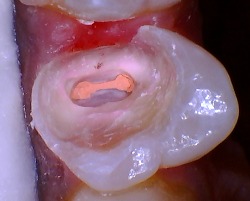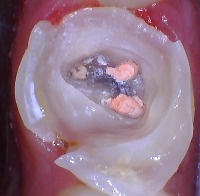Dental Core Build Up - Guide
- David Chen, DDS

- Aug 2, 2022
- 7 min read
Updated: Jan 10, 2024
A dental core build up is a composite resin filling material which is used to restore a tooth back to proper form in order to accommodate fitting a crown. If a buildup is needed and you don't get it, the dental crown may not fit properly or have trouble doing so. That can compromise the seal and integrity of your tooth underneath, which may lead to tooth decay.
However, depending on the situation you may or may not need one prior to having the crown made. Insurance does offer coverage for the dental core buildup procedure but that of course depends on your specific insurance plan.
The purpose of this guide is to inform you of what you need to know about the dental procedure called a core buildup.
Table of Contents:
How a core build up is done
A dental core buildup can only be done by a dentist because it requires equipment which you don't have at home. It typically requires some local anesthesia, followed by placing the core and then refining it.
Administer local anesthesia.
Remove all decay and unsupported tooth structure.
Apply conditioner, primer, and bond to tooth.
Place core build up material.
Wait for material to self cure or you can light cure it to speed it up.
Refine the core to make it smooth.
Before core placement
This is what a tooth, which needs a core buildup looks like before getting one:

These teeth which need a buildup typically are very uneven with sharp edges. They are not conducive to placing a crown on top because it does not have the proper shape nor form.
After core placement
This is what the same tooth as above looks like after the dental core buildup is placed:

Typically when your dentist is placing the core, they will overfill the tooth to ensure that the material reaches every nook and cranny. This overfilled looking buildup is not the prettiest but it at least looks better than what it was prior to getting one.
Finished core build up
This is what the tooth above looks like after refining and polishing up the buildup:

After the refining and polishing, doesn't the build up look significantly better? It looks very smooth and much more like a tooth. This is the proper form for what a tooth that is ready for crown placement should look like.
If you compare the appearance of the polished core vs the tooth without a core, you can already tell which one it is that you would want in your mouth. The former looks like a professionally completed work of art while the latter looks like unfinished business.
Next we will dive into the nitty gritty details about when the core is necessary and when it is not.
When a core build up is necessary
The dental core build up restores the proper shape of your tooth so that it can accommodate fitting a crown over it. It is always necessary after a root canal, sometimes for a crown, and once in a while for a dental veneer.
Always necessary after a root canal
It is absolutely necessary to have a core build up on your tooth after a root canal procedure. The primary reason for doing so is because the root canal specialist needs to drill through the tooth in order to reach the nerve. That pathway which the specialist creates is called an access opening.
These access openings tend to be fairly large and substantial in size. In addition to that, most of the teeth which require a root canal also tend to have large cavities in them. This means that not only the access opening needs to be created but all of the decay tooth structure needs to be removed as well. Both of these two factors combined, create a large hole in your tooth.
Here are some photos of what your teeth look like after a root canal procedure:
You can tell if a tooth had a root canal because you can see the root canal filling material inside of the tooth. This filling material is pink in color and easily distinguishable.
A commonality which is shared among all three of these after root canal treatment photos is that they are all missing a large chunk of tooth structure. The edges of the teeth also tend to be sharp as well. Consequently, you cannot place a crown on teeth that look like this. They will require a core buildup prior to making the crown.
Sometimes necessary for a dental crown
Unlike root canal treated teeth, teeth that need crowns without root canals don't always need a core. They only require it sometimes and it all depends on whether or not tooth decay is present.
If you are getting a crown but the tooth has a cavity in it, that decay will need to be removed prior to placing the crown on top. It is part of the standard of care to excavate all decay before covering the tooth with a crown. The reason is because if you leave decay underneath the crown, the cavity will grow and progress through the stages of tooth decay which will eventually cause you to have a root canal.
If the decay reaches the pulp, you will need a root canal. After that you'll need a core build up and then another crown made again. Essentially you've gone around in a circle and had to redo things twice. Instead of wasting your time and money, you might as well do it properly the first time. Then you also have to be mindful of how many times you can replace a crown because there is a limit.
Here is a photo of a decayed tooth underneath an existing crown which needs a new one:

This tooth needed a new crown because there was decay underneath of it. As you can see, all of that decay will need to be removed. However, you can't just palce a crown on top because you need to restore the tooth back to proper form so that it permits a crown to fit over it.
When we talk about having "proper form" we mean a tooth that is tapered without any undercuts. Removing tooth decay creates an undercut and that will prevent a crown from fitting. This is easily demonstrated by stacking cups on top of each other. Cups are tapered and don't have undercuts so that they fit over one another.
Here is a photo of cups fitting into one another:

Here is a photo when cups are not tapered and consequently do not fit into one another due to undercuts:

Dental crowns function the same way that cups fit over one another. They must be tapered and there cannot be any undercuts. This is why any tooth which has decay will require it to be removed and consequently a core build up to be performed.
Once in a while for dental veneers
Veneers are similar to crowns in that if there is tooth decay present, it will require a core build up. However, we say that veneers only require a build up once in awhile because most people who get veneers do it purely for cosmetic reasons. That means there is nothing wrong with the tooth structural aside from the fact that the patient does not like how it looks.
That tooth is structurally and functionally sound but it is having a veneer placed on it due to cosmetic reasons. Some common reasons are for changing the color of the teeth or changing the shape of them to be more aesthetically pleasing.
When a core buildup is not necessary
Core build ups are done to give crowns and veneers a better fit and are required if tooth decay is present. Inversely, it means that teeth which DO NOT have decay in them will not require a core build up.
An example would be if you were replacing a broken crown but it did not have any decay in it. Here is a photo showing a broken crown without a cavity:

For situations like these, you simply remove the rest of the broken crown and place a new one over the tooth. No core buildup is required at all since decay was not present and no cavity excavation was performed.
Here is a picture of what the new crown looks like:

Core build up vs Dental filling
A core build up shares many similarities with a dental filling but there are some differences, which mainly have to do with its physical properties.
Similarities:
They're both bonded in.
Made of a composite resin.
Replace missing tooth structure.
Differences:
Core buildups tend to be self cure or dual cure. This means that they will set on their own without a curing light. Dental fillings tend to require a curing light in order for them to set and harden.
Filling are more resistant to abrasion and have better wear characteristics. This means that core build ups that are used as a filling may not last as long because you may wear through them quicker from chewing on them. The reason is because cores are designed to be underneath of crowns and veneers so they are protected from outside elements. Fillings on the other hand are designed to weather the oral environment as is.
One final point we want to make is that you don't have to do a core build up after a root canal. You can place a filling in lieu of the buildup. The only downside is that it would make the procedure take longer because you need to place many layers of the filling and cure each layer prior to placing another one.
This takes time and is required because the curing light cannot cure through a very thick layer. There is a limit to the depth of cure. The core buildups circumvent this issue by self curing and do not require the curing light.
Alternatives
Instead of a core build up, your dentist may also choose to place a cast post and core or a prefab post and core. These defer from a regular core in that they also contain a post.
Dental core build up cost
Most dental insurances should cover a portion of the dental core build up. We've seen them cover roughly 50-80% of the procedural cost. Now whether or not you have coverage would depend on your specific plan benefits. If you chose a plan that did not have any coverage for a core then you would have to pay for it out of pocket.
The good news is that the out of pocket cost for a core buildup is very similar to the price of a filling. That means that the procedure isn't excessively expensive.
According to the American Dental Association (ADA) the average national fee for a buildup, which is dental code D2950, is about $282.49; If your insurance covered 80% of it then it would cost you $56.50 out of pocket. That is essentially your copay.
Takeaway
The purpose of a dental core build up is to restore a compromised tooth back to proper form so that it can fit a crown over it. It is always necessary after a root canal, sometimes needed for a crown and once in awhile for dental veneers. However there are certain situations where it may not be needed at all.
That of course is up to the discretion of your primary dentist. You should discuss with them whether or not you need a core. Last but not least, don't forget to go in for your six month dental check ups and cleanings so that you can prevent yourself from ever needing one!
Author: Written by Dr David Chen, a restorative dentist in long island city.







